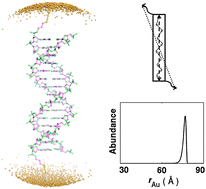Abstract
The natural stiffness of DNA, which contributes to the interactions of the many proteins involved in its biological processing and packaging, also plays an important role in modern nanotechnology. Here we report new Monte-Carlo simulations of deformable DNA molecules of potential utility in understanding the behavior of the long, double-helical polymer in the tight confines of a cell and in the design of novel nanomaterials and molecular devices. We directly determine the fluctuations in end-to-end extension associated with the conventional elastic-rod representation of DNA and with more realistic models that take account of the precise deformability of the constituent base-pair steps. Notably, the variance of end-to-end distance shows a quadratic increase with chain length in short chains of both types. We also consider the contributions to chain extension from the chemical linkages used to attach small molecular probes to DNA. The distribution of computed distances is sensitive to the intrinsic structure and allowed deformations of the tether. Surprisingly, the enhancement in end-to-end variance associated with the presence of the probe depends upon chain length, even when the probe is rigidly connected to DNA. We find that the elastic rod model of DNA in combination with a slightly fluctuating tether accounts satisfactorily for the distributions of end-to-end distances extracted from the small-angle X-ray scattering of gold nanocrystals covalently linked to the ends of short DNAs. There is no need to introduce additional structural fluctuations to reproduce the measured uptake in end-to-end fluctuations with chain length.


 Please wait while we load your content...
Please wait while we load your content...